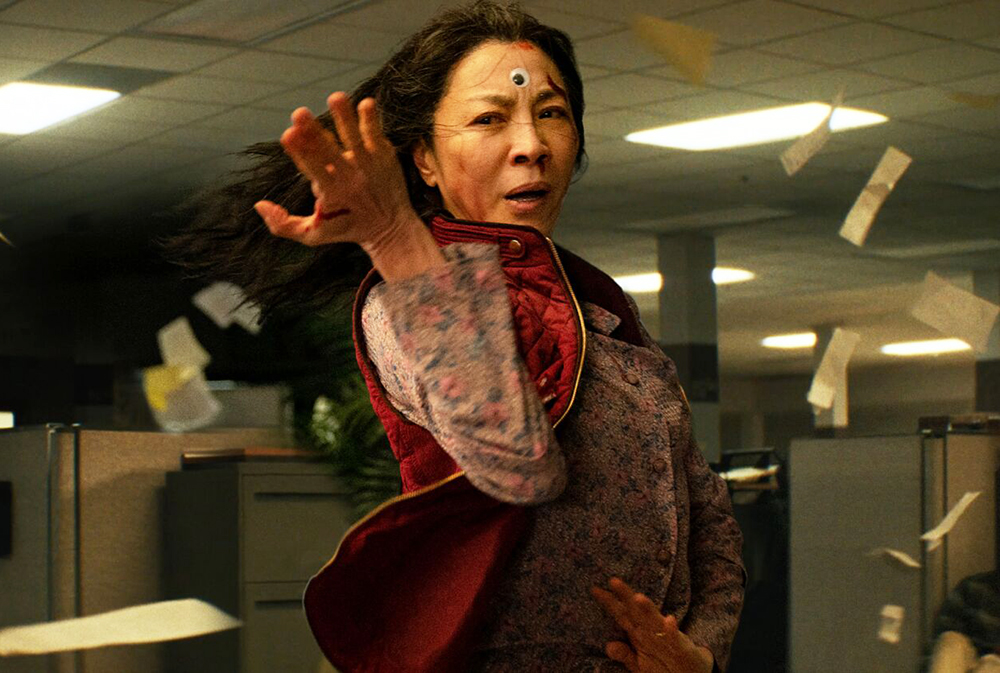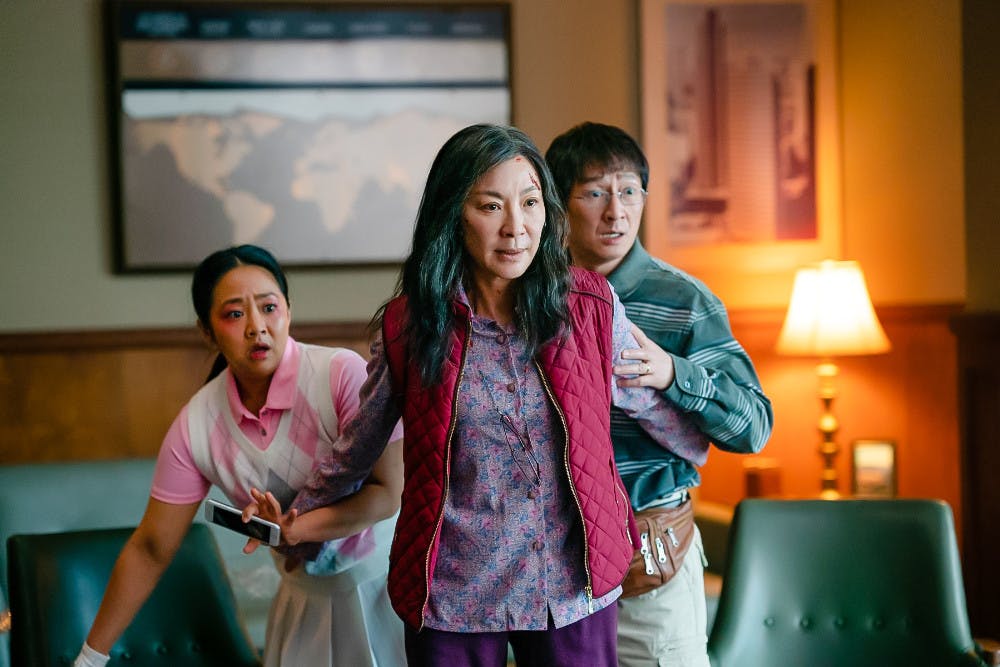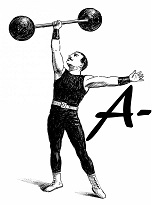The biggest comment floating around social media at the time of this film’s release was: “Everything Everywhere All at Once” was the multiverse movie “Doctor Strange in the Multiverse of Madness” should have been. I don’t particularly dig sound bites like this, and it does “EEAAO” an extreme disservice. The latter is a comic book movie sequel about a wizard traveling through a multiverse to stop a witch turned evil, and its multiverse is presented and accepted as entertainment. In the former, the “multiverse” is a cinematic tool to explore its central character’s missed opportunities, sadness, regret, and ultimate healing. They have nothing in common.
With that in mind, production company A24 is known for brining more artistic pictures to the fray, and “Everything Everywhere All at Once” is no exception. It’s directed—and written—by Dan Kwan and Daniel Scheinert, and tasks lead actress Michelle Yeoh with heavy lifting—and she delivers. The movie is presented as a hyper dream; its lead—and others—are catapulted through parallel and past universes. In their confines lies the many lives Yeoh’s Evelyn Wang could have lived should she have made the choice to not run away from her father at a young age and marry her husband, Waymond (Ke Huy Quan). The movie isn’t quick to explain the events and keeps us guessing. You have to dive in headfirst. If you spend any amount of time fighting “EEAAO’s” logic, you’ll have missed the point.
Just Going with ‘EEAAO’ Provides the Best Experience
Evelyn’s character is layered, and it’s a credit to Yeoh that she’s as likable as she is. We’ve seen in the opening that her husband wants to divorce her, she’s behind on her taxes, she lives in a tiny apartment and runs a failing laundromat, and works tirelessly to please her father (veteran James Hong), who treats her as a disappointment. She’s a bit of an enigma. Her daughter (Stephanie Hsu) is dating another girl (Tallie Medel), and though Evelyn reminds her she’s “lucky she has such an accepting mom” (a base exploration of Chinese culture comes into play), she’s still quick to judge her figure and tattoos, in one scene even telling her she’s “starting to get fat.” This sends a solemn tear down her daughter’s face in one of the film’s opening scenes.
You can easily see how “EEAAO” could at this point devolved into a standard parental disapproval tale, or a class parable (“Knives Out,” “Parasite,” and other recent films come to mind). However, what Kwan and Scheinert want to do is present a film that connects with you visually and emotionally. It shifts in and out of present reality to other “universes.” Evelyn’s guide is her husband; well he looks like the same guy, but he’s not. He explains the rules of the multiverse and explains that only she can help overthrow the threat, which is at first spearheaded by an IRS tax auditor (a stellar Jamie Lee Curtis), but is ultimately ‘masterminded’ by Jobu Tupaki, who looks an awful lot like her daughter, Joy.
An Absurdist Experience that Shows off Yeoh’s Martial Arts and the Filmmakers Vision in Equal Measure

Thus begins an assault on the senses that encapsulates the film’s first chapter, titled ‘Everything.’ Everything represents the hurriedness of Evelyn’s life. The continuing barrage of enemies that attack her. Her own demons. Regrets. Longing. In one universe she didn’t marry her husband and became a Kung Fu star and celebrity; in another a chef, and so on. The filmmakers assault our perceptions with engaging fights, philosophical battles of wits, and ‘verse jumping,’ in which characters do something usually very odd (while wearing Bluetooth headsets), and jump into another universe. These acts range from eating odd things, to giving oneself paper cuts, to sitting on statues naked… and we can probably stop there. The fights are especially intriguing. They clearly draw from “The Matrix” or “Kill Bill,” but lack the respective urgency or viciousness of those movies.
The cinematography is fitting, and Larkin Seiple shoots the scenes wonderfully. Sometimes you wonder what’s happening; in fact, for most of Part 1, that’s what you’ll doubtless feel. Yeoh superbly plays the floundering ‘hero’ that doesn’t know what she’s fighting for—not at first—and acts flabbergasted as the pieces come together. She gets to show off her martial arts skills (it’s the same Yeoh from “Crouching Tiger, Hidden Dragon,” after all). But it’s equally engaging to watch Ke Huy Quan play many characters—all more daring than her husband—and Stephanie Hsu as the ‘evil’ Jobu Tupaki. Tupaki mesmerizes Evelyn in one scene, drawing her into a black hole she’s made with her hopes, fears, and everything else she could think of; and it’s not hard to grasp the movie’s parallel that it’s Joy’s pain at not being accepted by her mom she’s sharing, not ideas of world domination.
Hard-Hitting Cinematography Coupled with Relatable Emotion
And, to me, this is where the film becomes wholly interesting. The hard-hitting fight scenes give way to something simpler and more sublime. Sometimes it takes a movie like this—one that jumps in and out of reason, timeframes, and dreams to allow audiences to feel its pain, rather than just to see it. The same was true of a forgotten indie (I doubt many know it, but I could be wrong) titled “Mr. Nobody” starring Jared Leto. Scenes with Lee Curtis, Huy Quan, and Hsu fill “EEAAO” with a dolor and sweetness that is indescribable. You just have to watch it and experience it. A scene between Yeoh and Hsu, as both are rocks sitting in a desert, talking, is one of the film’s most powerful scenes. As is a scene between Yeoh and a successful Waymond, in this universe whom she never married.

But not wanting to bore audiences, Kwan and Scheinert inject these themes—of love, loneliness, and a mother’s failing—with more fights, ‘verse jumping,’ and a kaleidoscope of lunacy. They become even more interesting as Evelyn ‘learns’ from her other lives, borrowing skills she uses to become a better fighter. The end fights, however, are the most insightful. As she makes her way up a flight of stairs guarded tooth and nail by guards and weaponry—her only goal to protect her daughter from turning away from her for good—the ways that she defeats her ‘enemies’ shows more empathy and insight than most dramas. The film’s ending is doleful and sublime, while grounded in realism. It’s not massive growth but subtle, and its clear Kwan and Scheinert want it to be believable.
A Film to Remember as We Head into Awards Season
“Everything Everywhere All at Once” is not a perfect film, even as we near award season and nomination(s) become likely. The film stretches on for too long (it’s 2 hours and 19 minutes), and sometimes feels like Kwan and Scheinert try to inject too much involving various family members instead of focusing on just Joy and Waymond. The ending reconnection between Joy and Evelyn almost nails it perfectly, then lags on a bit, pulling back, landing somewhere between complete acceptance and the same Evelyn we knew before. But all-in-all it’s forgivable. For its small faults, “EEAAO” presents a throughly-engaging and escapist fantasy complete with emotion, urgency, and soul. Its adventure propels its narrative, rather than being an end in itself, and leaves your heart warm as its credits roll. A film to make you think, and one to definitely check out if you’ve failed to see it thus far.
You can rent or stream “Everything Everywhere All at Once” on a variety of streaming platforms.
Support the Site: Consider becoming a sponsor to unlock exclusive, member-only content and help support The Movie Buff!


